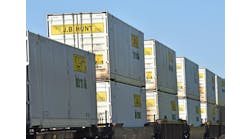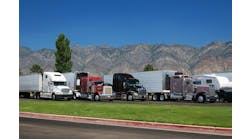When looking for an outsourcing partner, depending on the nature of the alliance, the size of the supplier can play a part in making the final choice. The size of the provider matters but it’s where that size is that makes the difference claims Jerry Levy, vice president of marketing for Agility. Customers should be looking at where there are low cost sourcing opportunities or where there is an opportunity for expanding markets, he advises, and then they should examine the size of potential logistics suppliers in that area.
As far as having presence in a market, Levy observes that, “The emerging market place is driving a lot of growth. Those markets are China, of course, but also Eastern Europe, the Middle East, Vietnam, and places like Sri Lanka, Indonesia and Latin America.” He sees a significant trend in what he terms Short Supply Chain shelf life. “It used to be if you built a manufacturing plant in an emerging market to supply developing countries, you might keep it there 15 years. Now companies set up in one area of the world and 24 months later are looking to relocate.”
While having presence in a location is important, Levy applies the concept of size to having knowledge of the local marketplace. “Because low cost sourcing opportunities are constantly changing manufacturers need to be looking at logistics providers that can very quickly establish supply chain operations in these emerging markets,” he notes. “They don’t necessarily have to have the assets sitting there. But they do need the intellectual skill sets.”
Something to be understood and what 3PLs assist with is helping to determine the total landed cost of conducting commerce off shore. A customer may find a low cost sourcing opportunity where manufacturing or retail expenses seem low but not take into account what transportation and supply chain support may cost for all logistic operations. Levy claims Agility has size and strength in the Middle East, Southeast Asia, Eastern Europe, Chile, Brazil and especially in India.
Because of its presence in Southeast Asia, it is operating two distribution centers for Nike in the region—one in Indonesia, the other in the Philippines, both of which are growing. “We enabled them to very quickly outsource to us pick and pack operations, shipment staging, tracking and reporting for distribution through the local markets,” he explains.
Because of Agility’s local experience in India it was able to win business by providing a custom solution for Germany’s Metro Cash & Carry. Metro has 615 stores in 29 countries that offer a broad selection of goods and services at wholesale prices to customers that include hotel and restaurant operators as well as small- and medium-sized retailers. Among its other offerings Metro Cash & Carry supplies fresh fish, meat, fruits and vegetables every day. The company now has several outlets around the country after its start in Bangalore in 2003.
Agility manages the company’s cool chain operations for fresh produce. “They faced issues that are typical in a developing market,” recalls Levy. “The produce had to be processed, stored and transported in very good condition in an optimum temperature environment. At the time they entered the Indian market—and it’s something often encountered in emerging markets— there was very little infrastructure for cool chain available. So we built our own facilities.” Agility has to manage movement of fresh produce across long distances through the hot and cold temperatures that are typical of India. “The good news for us, and this comes to intellectual skill sets,” says Levy, “is that we have a long term Agility team in India very experienced in managing general logistics challenges that require us to deploy our own assets.”
As does Agility’s Levy, Tom L. Jones, senior vice president and general manager of Supply Chain Solution of Ryder emphasizes the importance of total landed cost and the ability to manage it as key to success for any company. “It involves a very complex set of considerations that have to be put into the equation,” he reflects. “Then also you have to be able to change the supply chain as the parameters within the total landed cost calculation change as well. Take the matter of fuel, for example. It is changing the strategies of a lot of off shoring and moving it toward near shoring.”
The people factor is more important than ever in operating the supply chain and, according to Jones, it has become an issue with industry today. “That’s because the field is exploding and there is a lack of good, readily available talent throughout the world,” he claims. “The need is for people who can actually understand supply chains and think threedimensionally instead of two-dimensionally, because supply chains are pretty complex and are something in which relationships have to be understood.”
Jones recognizes the need for in-country people but argues they need to understand the global economy in addition to the local economy. In a global environment there have to be both shipping and receiving groups to comprehend what happens at both ends of the chain. When shipping globally anywhere there is a need for those well versed in world trade issues as well as local customs and the landscape of logistics throughout the region. Because of those requirements, Jones feels a larger provider offers greater access to those resources.
Something else that argues in favor of a larger supplier is the ability to devote a broad range of assets to a project. Those assets might include everything from trucks to warehousing. They may involve transportation management and the ability to procure services from other people. “Those are relatively large endeavors that a small logistics company might struggle with,” states Jones. “Because to keep on top of the technology, especially in warehousing, transportation management and online services, there is a significant investment companies have to make that needs to be leveraged across a very broad array. Otherwise, for just one customer it would be cost prohibitive.”
Jones points to the big systems needed to operate effectively globally. They are expensive and require people that can maintain the systems and react to technology issues relatively quickly and efficiently. “You have to have a backbone with an IT organization that is able to support the technology that’s being deployed on the customer’s behalf.”
Jones sees market strength for logistics providers like Ryder that have intellectual depth, geographic presence and technology and employ people that understand those relationships and are readily available for large customers. “That’s where real leverage comes,” he claims. “Because if you learn something on a landed cost calculation with customer A, more than likely that knowledge will help customer B as well.”
Ryder is a very powerful Americas logistics organization. In the Asia-Pacific region its focus is primarily on China. Jones characterizes the company as a very strong regional logistics provider with capabilities in the entire world. Ryder conducts a great deal of cross border operations with automotives in Canada. “In the US we are historically strong as an automotive provider,” he explains “We are strong in the high tech arena and in the fast moving goods, or retail, segment. That is one of our fastest growing areas. We are looking at the consumerism in the region and are crafting our products to reflect North American trends that include less manufacturing, more consuming.”
What a large 3PL can do for its customers goes beyond just moving the material, notes Jones. Its benefits involve the customer’s shelf, manufacturing plant and suppliers. He claims that, “All the elements of the supply chain important to success are things customers don’t necessarily see in a cost sheet, but those are the advantages they get from an industry leader.”


